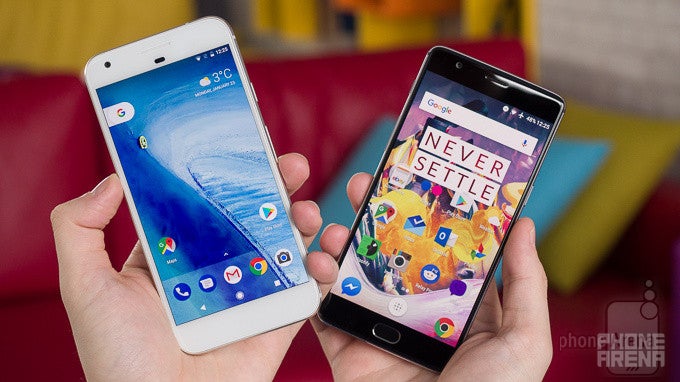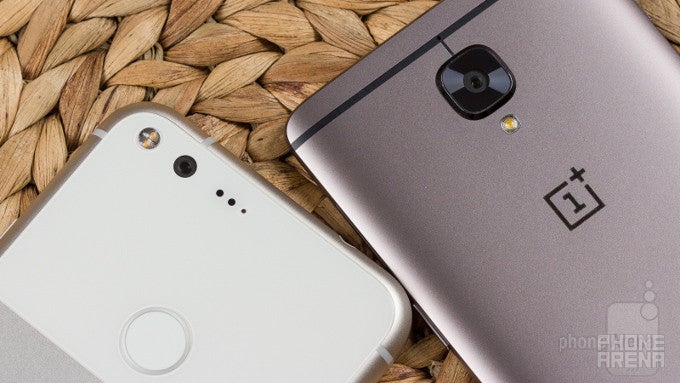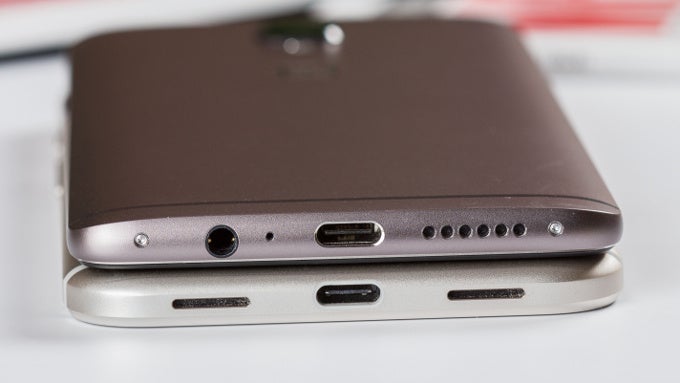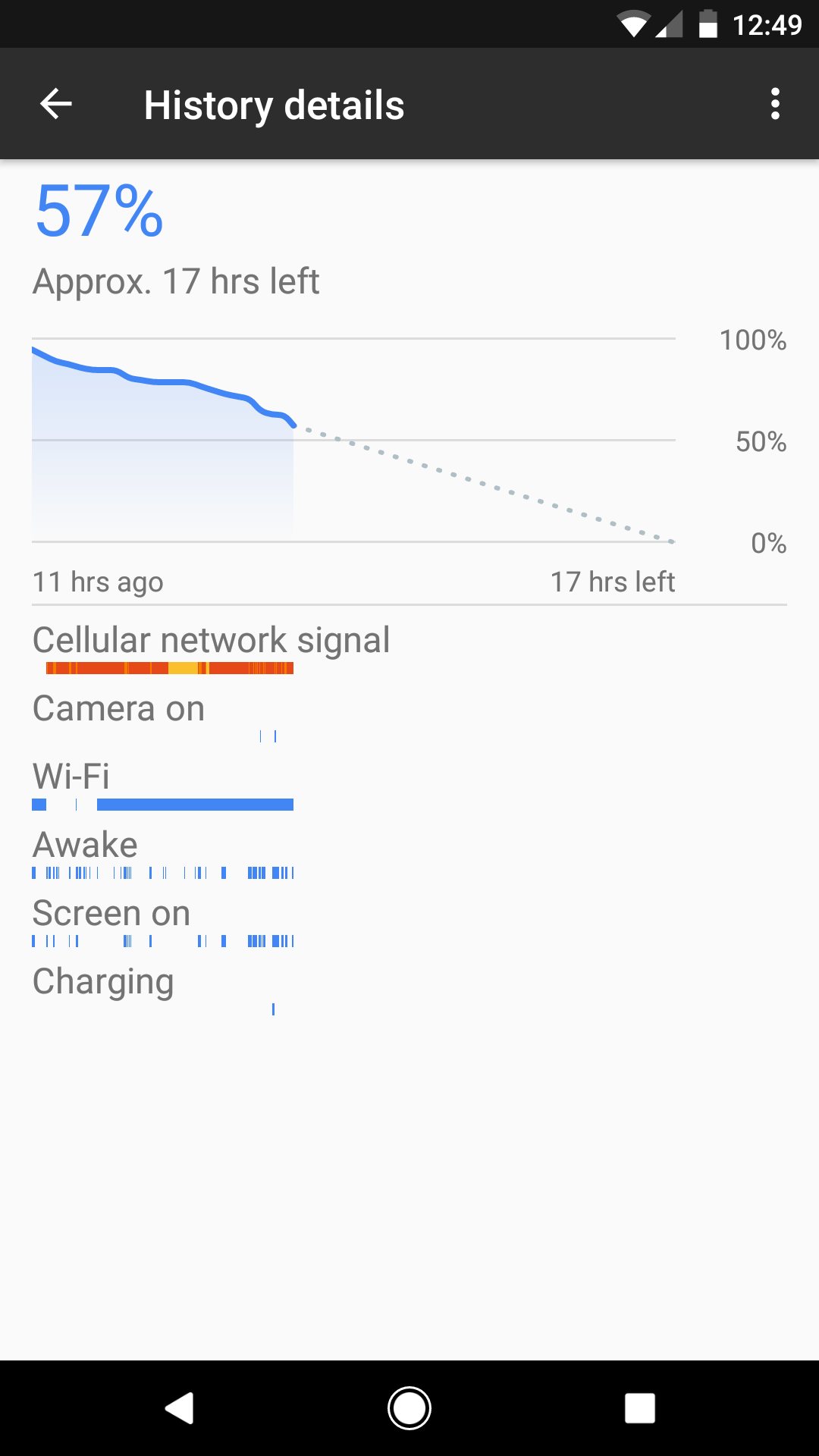Google Pixel XL vs OnePlus 3T

Google has a distinct vision for how the Android platform should look like: the company debuted its Material Design paradigm a few years ago, and it’s a flat and modern look that many customers have grown fond of.
If you are looking for a good modern phone that sticks close to those principles you inevitably bump against two names: the Google Pixel series and the affordable OnePlus series. We thought a proper comparison between the two was long due, and that’s why we have the 5.5-inch Google Pixel XL against the equally sized OnePlus 3T. Which is the better phone? What are the pros and cons of each? Let’s find out.
Design and Display
Slim and good-looking, the OnePlus 3T scores design points. The Pixel XL, however, feels a bit more solid and has a reassuring heft to it.
The Pixel XL is certainly one polarizing design: some like it, others go as far as to claim that it’s one of the uglier designs they have seen. You can’t argue with subjective opinion, but what we can say is that it is a solidly built phone with a nice heft to it and a comfortable in-hand fit. It has a slight curve around the side that helps you pick it off a table easier and the glass accent on the back gives it character.
The OnePlus is also slightly more compact in terms of physical size, which many people will value.
Neither phone is water-proof and both reassuringly have a 3.5mm headset jack. Both sport fingerprint scanners as well, but we find the front-positioned finger reader on the OnePlus at a more comfortable spot, while the rear one on the Pixel is a bit more accurate, but in certain situations it’s a pain to reach.
The overly sensitive OnePlus screen results in accidental taps and mishaps
Both the OnePlus and the Pixel use AMOLED screens of the same 5.5-inch size, and both default to vivid, eye-popping color that many people like. Both phones also support an sRGB mode that dials tones down to deliver a more realistic picture, and those who value accurate color representation might prefer that mode. Both phones also have the neat blue light filter for night use, but it looks better on the Pixel, while the OnePlus turns to a strange, yellow-ish shade.In our daily use, we noticed how the thinner bezel on the OnePlus display combined with the very sensitive screen results in accidental taps, mistakenly closing apps, and other annoying mishaps. This was much less of an issue on the Pixel, and it’s something that could spoil the smartphone experience a lot.
Interface and Performance
The OnePlus has a clean and fast interface, but the Pixel one-ups it with smoother performance and Google Assistant, possibly the best and fastest voice assistant.
While both phones run a very clean build of Android, there is a bigger difference than just version numbers here.
This difference is in the new Google Assistant that sits front and center at the Pixel experience (just press and hold the circle on-screen button from your home screen), and is missing on other phones, including the OnePlus 3T.
So what is the Google Assistant? It is a big first step towards a ‘smarter’ smartphone, and it brings up contrasting feelings as it’s both a big step and a first step. Here are all the great things about it: it’s an extremely fast (it’s much faster than anything else you’ve tried) and accurate assistant, it recognizes all sorts of accents with an amazing precision, and it understands context (start asking about a person and a team, and you can continue with your questions without mentioning the name of the team, while the Assistant understands that you’re still asking about the same person or team).
The Google Assistant is the big difference between the two
On the other hand, though, it still does not know enough about you, does not know enough about the world and current events, and this severely limits the ways that you can use it. And fact remains that most non-techy people do need a pretty solid reason to start talking to a phone. Sure, you can ask it about the weather, directions and calendar appointments, but you already have great and more detailed apps with that information available at a single tap on your phone home screen.Google Assistant aside both phones get two things right about the Android experience: speed and simplicity. Both come bloatware-free and both run impressively well, but it is the Pixel XL that has more fluidity and a very nice smooth flow of use, while the OnePlus lacks the animations that make a fast phone feel fluid.
At the time of this writing, both phones run on Android 7 Nougat, but some of the signature features of the Pixel are missing on the OnePlus. For instance, the swipe up gesture to bring the app drawer is absent on the OnePlus, and you don’t have the long-press on an icon to get quick shortcuts action, so the experience does differ a bit and we feel that it differs in favor of the Pixel. We also like the added support for landscape use in the Pixel home screen.
There is also a new vibration mechanic on Google’s first own phone, but the feedback it provides feels rather vague and we can’t say that it improves the experience in any significant way.
Camera
The OnePlus has a good camera, but the Pixel XL has a great camera: with wider dynamics, faster focusing and better stabilization.

Let’s get the specs out of the way: the Pixel XL has a 12-megapixel camera with f/2.0 aperture lens and larger individual pixels, while the OnePlus 3T features a 16MP camera with f/2.0 aperture. The camera on the Pixel XL does not have optical image stabilization (Google says that’s an intentional choice) and the camera is beautifully flush with the body, while the OnePlus has OIS and also the camera bulges out the back.
You will also notice that in the camera app on the Pixel, as you shoot, everything shakes a lot because of the lack of OIS, but don’t worry: the phone manages to stabilize the image and you still get sharp shots.
The Pixel has also got an impressively quick auto focusing, a bit faster than on the OnePlus. This is great for photography, but is even more important for video. While the OnePlus occasionally has trouble staying in focus, the Pixel will switch and hold focus quickly and reliably. And despite not having optical stabilization, the software stabilization that it uses in 4K makes a big difference and provides some of the smoothest, most stable videos on a mobile phone. The OnePlus is not bad, but it does not live up to that higher standard.
Sound

The Pixel has a speaker with rich, full sound
Audiophiles will scorn you for listening to music via your smartphone speakers, but the reality is that many people do often watch YouTube videos and the quality you get from those small phone speakers matters.Both the OnePlus and the Pixel have a single bottom-firing speaker, but it is again the Pixel that pumps out not only louder, but fuller, juicier sound with a lot of definition.
Both phones also have a 3.5mm headset jack, which might not be the technology of the future, but is still the technology of today.
Battery life
Both will get you through a full day of use and both feature fast charging, but the Pixel XL lasts a bit longer.

The Pixel XL delivers more solid battery life
Both also support quick charging and here the OnePlus has a speed advantage: it takes just one hour and twenty five minutes to fully charge its battery, while the Pixel is fast, but not as fast with charging speeds of nearly two hours.
However, the OnePlus also uses a proprietary charging technology requiring a special OnePlus cable (it’s a thicker cable that allows for the higher current to pass), so its quick charging solution called Dash Charge won’t work with a regular USB-C cable. Not a dealbreaker, but something to consider nonetheless.
Conclusion
The big difference between the Google Pixel XL and the OnePlus 3T is in price: while an unlocked Pixel XL costs a full flagship price of $770, the OnePlus 3T is sold for just $440. The Pixel XL, however, works on Verizon Wireless (and is sold via the carrier), while the OnePlus 3T will only work on AT&T and T-Mobile.
At its alluring price, the OnePlus 3T is an excellent value for the money and a great phone all around. However, if money is no concern, the Pixel XL does a little bit better in every aspect: its battery lasts a bit longer, its camera takes slightly better pictures and videos, its display looks a little bit better, it’s got that new Google Assistant and it comes with the promise of day 1 Android updates. Yes, it also works a little smoother, with more pleasing animations and overall experience.
Follow us on Google News









![A new Android bug is making it impossible to install new apps. Are you affected? [UPDATE]](https://m-cdn.phonearena.com/images/article/176703-wide-two_350/A-new-Android-bug-is-making-it-impossible-to-install-new-apps.-Are-you-affected-UPDATE.webp)

Things that are NOT allowed:
To help keep our community safe and free from spam, we apply temporary limits to newly created accounts: